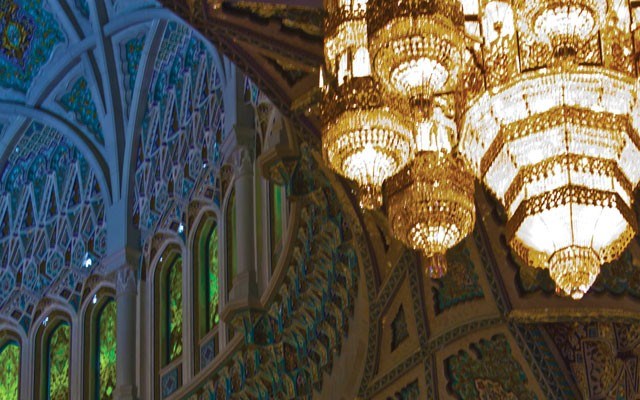The four-lane highway winds through the desert. There are occasional walled houses and a few bushes but there are no signs of life. In the distance there is the rocky outline of an arid mountain range but the desert heat makes it blurry and indistinct.
It is hot outside. Very hot! I have never experienced 48 degrees Celsius before and I don't like it. We, however, are cocooned in air-conditioned comfort in the back seat of a limousine. We are struggling to keep awake.
My wife and I are in Oman, an Arab state on the southeast coast of the Arabian Peninsula. We have flown in from Europe and arrived without sleep. Now nine hours later, jetlag and the heat is catching up with us. Never-the-less we are having a great time.
Saif, our driver, has shown us around Muscat, the capital city of Oman. Known for 2,000 years as an important trading port between the West and the East, Muscat has been ruled by various indigenous tribes, as well as the Persians and the Portuguese at various points in its history.
Muscat is a spread-out city of mainly low-rise white buildings. The port-district with its waterfront road and harbour forms the north-eastern periphery of the city. This is probably the most interesting area for visitors although most of the better accommodation is elsewhere.
The Al Jalali Fort and the Al Mirani Fort, which were built as prisons in the 1580s during the Portuguese occupation, and the Qasr Al Alam Royal Palace which stands at the head of a natural deep harbour are all interesting.
The amazing Mutrah Souk, where we bargain for Arab hand-embroidered shawls, nuts, spices, and incense, is perhaps our favourite. The maze-like souk is often described as the best in the Gulf region and it has numerous shops for gold, jewelry, traditional Omani handicrafts and Omani food at reasonable prices.
Next stop is the fish market on the waterfront where the main fish hall is full of traders in traditional dress selling everything from shell fish to gigantic tuna. We watch as a boat arrives laden with the catch and the nets are cleared. The crew fillet the fish with a skill and rapidity which is stunning.
The city has numerous mosques including the Sultan Qaboos Grand Mosque. This is the third largest mosque in the world and non-Muslims may visit from 8 a.m. to 11 a.m. every day except Friday. Ladies are expected to keep their heads, ankles and wrists covered while visiting the mosque.
The whole complex is stunning. Highlights are the gigantic Swarovski crystal chandelier, the enormous hand-made Persian carpet which took 600 women three years to make, and the marble panelling.
There are several forts outside the city with Nakhal Fort first on our list. The fort lies at the foot of the Hajar Mountains about an hour from Muscat and it has a commanding view of all its surrounds.
The interior is characterised by open stairways, arched recesses, a multitude of rooms with windows shuttered by beautiful wooden carvings, and ceilings of latticed palm matting supported by polished mangrove and palm timbers. Today it is a welcoming place for visitors, but in the old days the ill-intentioned would not have found it so.
With six rounded towers armed with cannon and innumerable apertures for small arms in its tremendously thick walls, the fort was able to use its weapon systems against a hostile approach from any direction.
Many rooms are restored to their original condition, with rows of cushions bordering carpets, and weapons hanging on the walls. The interior of the fort is surprisingly cool so we linger in the shade admiring the many beautiful artefacts.
Not far from the fort is the Al Thowrah hot spring. The last stretch of road to the spring runs through lush date palm plantations and farm dwellings. The spring flows into a pool and trickles over a weir to the wadi floor. The area is lush and popular with locals and we quickly find friends.
We drive on to Rustaq through the Jebel Akhdar Mountains. Rustaq was once the capital of Oman and the attraction is Rustaq fort. This is perhaps the oldest fort in Oman as it was first started by the Persians about 1500 years ago. Since then it has been extended and restored and today it is an imposing structure built on three levels, containing separate houses, an armoury, a mosque and four towers. Rustaq also has a covered souk and modern shops, and near the entrance to the town there is a hot spring.
Oman has much more to offer. The drive south to Sur is highly recommended. Stop at the fishing village of Quriyat, which was a major port centuries ago then visit Wadi Shab one of several wadis with running water, pools studded with dramatic boulders and a cave.
Sur, a placid sea coast town with its striking traditional dwellings, is famous for its dhow shipyards and is the presumed home of the legendary Sinbad the Sailor.
Another wonderful place to visit is Nizwa, a verdant oasis city with its blend of the modern and the ancient. This was the capital of Oman during the 6th and 7th century and it is famous for its historical monuments, handicrafts and agricultural products. Nizwa fort, completed in the 1650's is Oman's most visited National monument.
IF YOU GO: Most visitors need a visa to visit Oman, but many nationals of European, North and South American, Asian and Oceania countries can obtain this at the airport on arrival. Taxis are available from the airport to your hotel for around $18.
We found the people to be courteous and friendly and they will go out of their way to help a visitor. Many speak good English. You don't get to see Muscat fully unless you have a car. The public transport system is limited and not available in all areas. You can rent a car with a driver or take tours.




